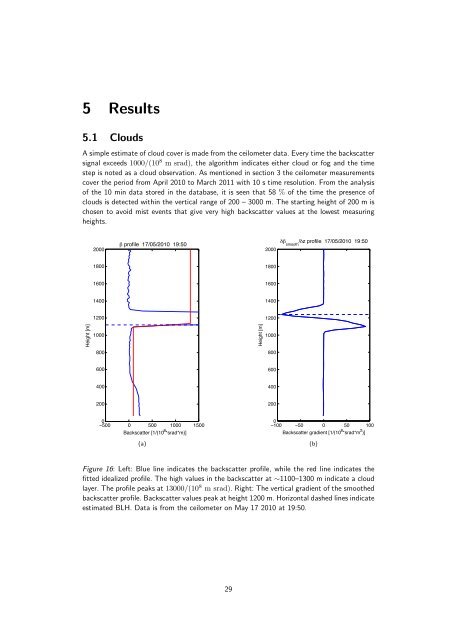Boundary-layer height detection with a ceilometer at a coastal ... - Orbit
Boundary-layer height detection with a ceilometer at a coastal ... - Orbit
Boundary-layer height detection with a ceilometer at a coastal ... - Orbit
You also want an ePaper? Increase the reach of your titles
YUMPU automatically turns print PDFs into web optimized ePapers that Google loves.
5 Results<br />
5.1 Clouds<br />
A simple estim<strong>at</strong>e of cloud cover is made from the <strong>ceilometer</strong> d<strong>at</strong>a. Every time the backsc<strong>at</strong>ter<br />
signal exceeds 1000/(10 8 m srad), the algorithm indic<strong>at</strong>es either cloud or fog and the time<br />
step is noted as a cloud observ<strong>at</strong>ion. As mentioned in section 3 the <strong>ceilometer</strong> measurements<br />
cover the period from April 2010 to March 2011 <strong>with</strong> 10 s time resolution. From the analysis<br />
of the 10 min d<strong>at</strong>a stored in the d<strong>at</strong>abase, it is seen th<strong>at</strong> 58 % of the time the presence of<br />
clouds is detected <strong>with</strong>in the vertical range of 200 – 3000 m. The starting <strong>height</strong> of 200 m is<br />
chosen to avoid mist events th<strong>at</strong> give very high backsc<strong>at</strong>ter values <strong>at</strong> the lowest measuring<br />
<strong>height</strong>s.<br />
2000<br />
! profile 17/05/2010 Smoothed**profile 19:50 17/05/2010 19:50<br />
2000<br />
2000<br />
smooth<br />
/z profile 17/05/2010 19:50<br />
1800<br />
1800<br />
1800<br />
1600<br />
1600<br />
1600<br />
1400<br />
1400<br />
1400<br />
1200<br />
1200<br />
1200<br />
Height [m]<br />
1000<br />
Height [m]<br />
1000<br />
Height [m]<br />
1000<br />
800<br />
800<br />
800<br />
600<br />
600<br />
600<br />
400<br />
400<br />
400<br />
200<br />
200<br />
200<br />
0<br />
0<br />
−500 0 5000 1000 0 1500 5000 10000<br />
Backsc<strong>at</strong>ter [1/(10 8 *srad*m)] Backsc<strong>at</strong>ter [1/(10 8 srad m)]<br />
(a)<br />
0<br />
100 50 0 50 100<br />
Backsc<strong>at</strong>ter gradient [1/(10 8 *srad*m 2 )]<br />
(b)<br />
Figure 16: Left: Blue line indic<strong>at</strong>es the backsc<strong>at</strong>ter profile, while the red line indic<strong>at</strong>es the<br />
fitted idealized profile. The high values in the backsc<strong>at</strong>ter <strong>at</strong> ∼1100–1300 m indic<strong>at</strong>e a cloud<br />
<strong>layer</strong>. The profile peaks <strong>at</strong> 13000/(10 8 m srad). Right: The vertical gradient of the smoothed<br />
backsc<strong>at</strong>ter profile. Backsc<strong>at</strong>ter values peak <strong>at</strong> <strong>height</strong> 1200 m. Horizontal dashed lines indic<strong>at</strong>e<br />
estim<strong>at</strong>ed BLH. D<strong>at</strong>a is from the <strong>ceilometer</strong> on May 17 2010 <strong>at</strong> 19:50.<br />
29
















